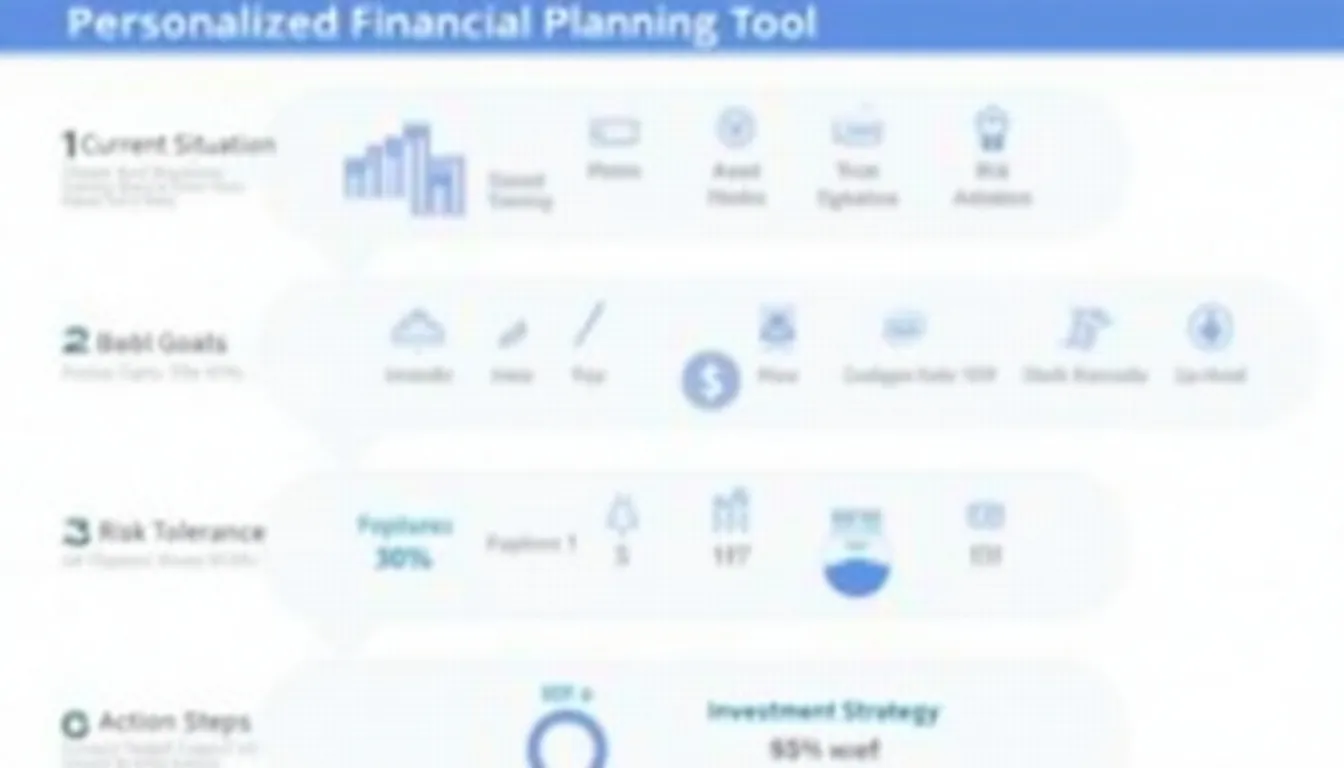Is this tool helpful?
How to Use the Financial Planning Tool Effectively
To make the most of our comprehensive Financial Planning Tool, follow these steps:
- Describe the Client’s Financial Situation: In the first text area, provide a detailed description of the client’s current financial status. Include information such as:
- Monthly income (e.g., $5,000 from salary, $1,000 from rental property)
- Major expenses (e.g., $1,500 for mortgage, $500 for car payment)
- Savings (e.g., $10,000 in emergency fund)
- Investments (e.g., $50,000 in 401(k), $20,000 in stocks)
- Outstanding debts (e.g., $200,000 mortgage, $15,000 car loan)
- List Financial Goals: In the second text area, outline the client’s short-term and long-term financial objectives. For example:
- Short-term: Save $20,000 for a down payment on a house within 2 years
- Long-term: Retire by age 60 with $1.5 million in savings
- Mid-term: Start a small business within 5 years with $100,000 capital
- Specify Risk Tolerance: Enter the client’s risk tolerance level in the designated field. This could be:
- Conservative: Prioritizes capital preservation
- Moderate: Balances growth and security
- Aggressive: Focuses on high-growth opportunities
- Indicate Industry (Optional): If relevant, enter the client’s industry or business type. This information can help tailor the financial advice to specific sector-related opportunities or challenges. For instance:
- Technology: May consider stock options or startup investments
- Healthcare: Could explore health savings accounts (HSAs)
- Retail: Might need to account for seasonal income fluctuations
- Generate the Financial Plan: Click the “Generate Financial Plan” button to receive a customized financial strategy based on the provided information.
After submitting the form, you’ll receive a comprehensive financial plan tailored to the client’s specific situation and goals.
Understanding the Financial Planning Tool: Your Path to Fiscal Success
Our Financial Planning Tool is a sophisticated, AI-powered solution designed to provide personalized financial advice and strategies. It acts as a virtual accountant, leveraging advanced algorithms and financial expertise to create comprehensive financial plans tailored to individual client needs.
Purpose and Benefits
The primary purpose of this tool is to democratize access to high-quality financial planning services. It offers several key benefits:
- Personalization: By considering individual financial situations, goals, and risk tolerances, the tool provides truly customized advice.
- Comprehensive Approach: It addresses various aspects of financial planning, including budgeting, investment strategies, and risk management.
- Time and Cost Efficiency: Users can receive professional-grade financial advice without the need for multiple consultations or high fees.
- Accessibility: The tool is available 24/7, allowing users to plan their finances at their convenience.
- Educational Value: Users gain insights into financial planning principles and strategies as they interact with the tool.
Unlocking Financial Success: Benefits of Our Planning Tool
1. Holistic Financial Assessment
Our tool provides a comprehensive evaluation of your financial health, considering income, expenses, assets, and liabilities. This holistic view helps identify areas of strength and opportunities for improvement in your financial life.
2. Goal-Oriented Planning
By aligning financial strategies with your specific short-term and long-term goals, the tool ensures that every financial decision you make is a step towards achieving your aspirations, whether it’s buying a home, starting a business, or retiring comfortably.
3. Risk Management
The tool factors in your risk tolerance to create a balanced financial plan that optimizes potential returns while maintaining a comfortable level of risk. This approach helps protect your financial future from unforeseen circumstances.
4. Investment Optimization
Leveraging advanced investment strategies, the tool provides recommendations for portfolio allocation that align with your goals and risk profile. This can potentially enhance your investment returns over time.
5. Tax Efficiency
While not a substitute for professional tax advice, the tool considers general tax implications in its recommendations, potentially helping you maximize your after-tax returns and minimize tax liabilities.
6. Budgeting Assistance
The tool helps create a realistic budget based on your current financial situation, helping you manage expenses, increase savings, and work towards your financial goals more effectively.
7. Financial Education
As you use the tool and implement its recommendations, you’ll gain valuable insights into financial planning principles, empowering you to make more informed financial decisions in the future.
Addressing User Needs: How Our Tool Solves Financial Planning Challenges
Challenge 1: Lack of Comprehensive Financial Overview
Many individuals struggle to get a clear picture of their overall financial health. Our tool addresses this by consolidating all financial information – income, expenses, assets, and liabilities – into a comprehensive overview.
Example Calculation:
Let’s say a user inputs the following information:
- Monthly Income: $6,000
- Monthly Expenses: $4,500
- Assets: $100,000 (savings and investments)
- Liabilities: $150,000 (mortgage and car loan)
The tool would calculate:
- Monthly Cash Flow: $6,000 – $4,500 = $1,500
- Net Worth: $100,000 – $150,000 = -$50,000
This overview helps the user understand their current financial position and identifies areas for improvement, such as increasing savings or reducing debt.
Challenge 2: Difficulty in Setting Realistic Financial Goals
Many people struggle to set achievable financial goals. Our tool helps by analyzing the user’s current financial situation and providing guidance on realistic goal-setting.
Example Calculation:
If a user wants to save $100,000 for a house down payment in 5 years, the tool would calculate:
$$ \text{Monthly Savings Required} = \frac{\text{Goal Amount}}{\text{Number of Months}} $$$$ \text{Monthly Savings Required} = \frac{\$100,000}{60 \text{ months}} = \$1,666.67 $$The tool would then compare this to the user’s current monthly cash flow ($1,500 in our previous example) and suggest adjustments to make this goal achievable, such as increasing income or reducing expenses.
Challenge 3: Optimizing Investment Strategies
Many individuals are unsure how to allocate their investments effectively. Our tool provides personalized investment recommendations based on the user’s risk tolerance and financial goals.
Example Calculation:
For a user with a moderate risk tolerance and a long-term goal of retirement in 30 years, the tool might recommend the following portfolio allocation:
- 60% Stocks (for growth)
- 30% Bonds (for stability)
- 10% Cash (for liquidity)
The tool would then calculate potential returns based on historical market data:
$$ \text{Projected Annual Return} = (0.60 \times 8\%) + (0.30 \times 4\%) + (0.10 \times 1\%) = 6.1\% $$This helps the user understand the potential growth of their investments over time and adjust their savings strategy accordingly.
Practical Applications: Real-World Use Cases
Use Case 1: Young Professional Planning for the Future
Sarah, a 28-year-old software engineer, uses the Financial Planning Tool to create a roadmap for her financial future. She inputs her current salary of $80,000, monthly expenses of $3,500, student loan debt of $30,000, and a desire to buy a house and retire by 60.
The tool provides Sarah with a comprehensive plan that includes:
- A budget to pay off her student loans within 5 years
- A savings strategy to accumulate a down payment for a house within 3 years
- An investment plan that balances aggressive growth for retirement with shorter-term stability for her house down payment
- Recommendations for maximizing her company’s 401(k) match and opening a Roth IRA
Use Case 2: Mid-Career Couple Balancing Multiple Financial Goals
John and Maria, both 45, use the tool to balance saving for their children’s college education and their own retirement. They input their combined income of $150,000, monthly expenses of $8,000, current savings of $200,000, and goals of funding college for their two children (ages 10 and 12) and retiring at 65.
The tool provides a plan that includes:
- Strategies for maximizing contributions to 529 college savings plans
- Recommendations for increasing retirement savings, including catch-up contributions to their 401(k)s
- A revised budget that identifies areas where they can reduce expenses to boost savings
- Investment strategies that gradually shift from growth to more conservative options as they approach retirement
Use Case 3: Small Business Owner Planning for Retirement
Tom, a 50-year-old restaurant owner, uses the tool to plan for his retirement. He inputs his variable income (averaging $120,000 annually), business value of $500,000, and personal savings of $300,000. He wants to retire at 65 and potentially sell his business.
The tool provides Tom with:
- Strategies for managing irregular income, including setting up a cash reserve for lean months
- Recommendations for retirement accounts suitable for small business owners, such as a SEP IRA or Solo 401(k)
- A plan for gradually transitioning out of the business, including steps to increase its value for a potential sale
- Investment strategies that consider his business as part of his overall asset allocation
Frequently Asked Questions (FAQ)
Q1: How often should I update my financial plan?
A1: It’s recommended to review and update your financial plan at least annually or whenever you experience significant life changes such as marriage, birth of a child, job change, or major asset purchase/sale.
Q2: Can this tool replace a human financial advisor?
A2: While our tool provides comprehensive financial planning advice, it’s designed to complement rather than replace human advisors. For complex situations or personalized guidance, consulting with a professional financial advisor is still recommended.
Q3: How does the tool determine investment recommendations?
A3: The tool considers factors such as your age, income, financial goals, risk tolerance, and current financial situation to provide investment recommendations. These are based on widely accepted financial principles and historical market data.
Q4: Can I use this tool if I’m self-employed or have irregular income?
A4: Absolutely! The tool is designed to accommodate various income situations. For irregular income, you can input your average monthly or annual income, and the tool will provide strategies for managing variable cash flow.
Q5: Does the tool consider inflation in its calculations?
A5: Yes, the tool factors in average historical inflation rates when projecting future expenses and calculating the amount needed for long-term goals like retirement.
Q6: How does the tool handle debt repayment strategies?
A6: The tool analyzes your debts and provides recommendations based on widely-used strategies such as the debt avalanche method (paying off highest interest debt first) or the debt snowball method (paying off smallest debts first for psychological wins).
Q7: Can the tool help with estate planning?
A7: While the tool primarily focuses on personal financial planning, it can provide general guidance on estate planning considerations. However, for detailed estate planning, it’s advisable to consult with a legal professional.
Q8: How does the tool account for major life events in financial planning?
A8: The tool allows you to input major life goals (such as buying a house or starting a family) and adjusts its recommendations accordingly. It’s important to update your plan as these events occur or your goals change.
Q9: Can the tool help with tax planning?
A9: The tool provides general tax-efficient strategies based on your financial situation. However, for specific tax advice, especially for complex situations, consulting with a tax professional is recommended.
Q10: How secure is my financial information when using this tool?
A10: We take data security seriously. All information entered into the tool is encrypted and not stored after your session ends. However, always ensure you’re using the tool on a secure, private network.
Important Disclaimer
The calculations, results, and content provided by our tools are not guaranteed to be accurate, complete, or reliable. Users are responsible for verifying and interpreting the results. Our content and tools may contain errors, biases, or inconsistencies. We reserve the right to save inputs and outputs from our tools for the purposes of error debugging, bias identification, and performance improvement. External companies providing AI models used in our tools may also save and process data in accordance with their own policies. By using our tools, you consent to this data collection and processing. We reserve the right to limit the usage of our tools based on current usability factors. By using our tools, you acknowledge that you have read, understood, and agreed to this disclaimer. You accept the inherent risks and limitations associated with the use of our tools and services.







